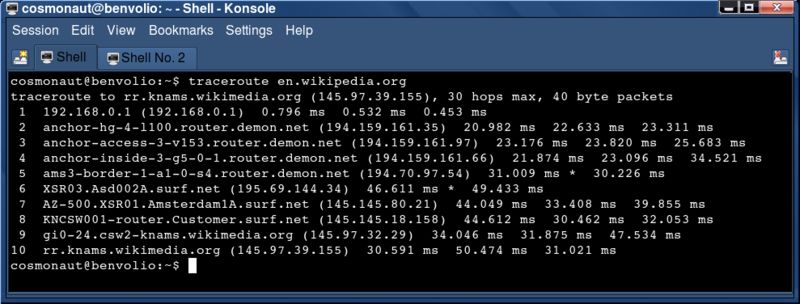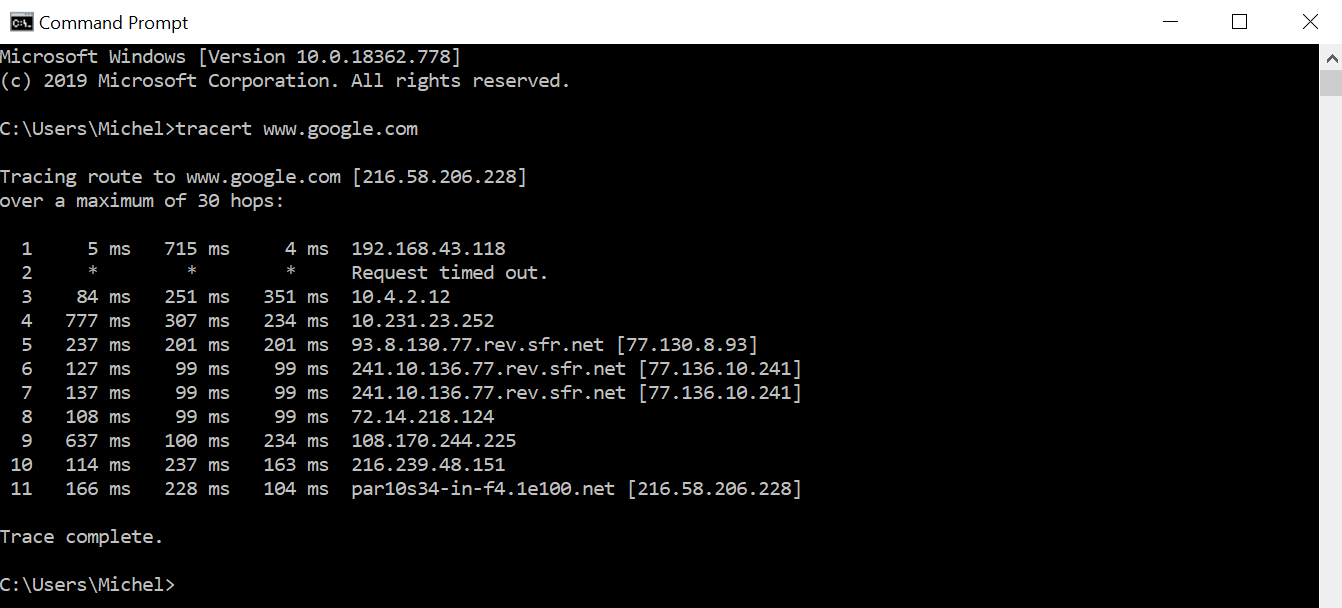
[ad_1]
As you employ the web, it’s very easy to overlook that there are a variety of working components and servers that assist preserve the World Large Net alive. Each packet you ship, from a chat message to a cat photograph, has to journey by means of exchanges and servers to succeed in its vacation spot.
Sadly, nothing higher reminds you of this setup than when you’ll be able to now not hook up with an internet site. The trigger could also be someplace in your facet, on the web site’s facet, or someplace in between. And one of the best ways to determine the place the issue sits is by utilizing Traceroute.
What Is Traceroute?
Traceroute is a option to hint the route your information packets take as they make their approach by means of the web. Each fashionable working system can hint a route.
While you begin a Traceroute, you inform it which web site or server you wish to hint a path to. Usually, it is a web site URL that you just’re attempting to succeed in, however you can even feed it an IP tackle in case you like.
When you’ve initiated Traceroute, it sends packets in direction of your set vacation spot. It then logs the packet’s travels and sends the knowledge again to your PC, which then reveals you the place they’re going.
That is actually useful in case you’re looking for a fault on the community. If a server or trade is down, Traceroute will encounter the difficulty and report again that one thing is not working accurately. You may then use this info to raised diagnose what is going on flawed.
How Does Traceroute Work?
Traceroute is a useful option to diagnose community errors. Nevertheless, Traceroute’s invention is all due to a intelligent exploit utilizing a packet’s “Time-to-Stay” variable.
What Is a Packet’s “Time-to-Stay”?
Ideally, when a pc sends a packet from one place to a different, it will get there with none challenge. It takes the quickest route it could possibly from level A to level B and doesn’t get caught or held up.
Sadly, networks may be finicky issues. If an engineer makes a mistake whereas organising a server, it’s attainable for packets to be despatched in an infinite loop between servers. And if that occurs too typically, a community may be stuffed filled with packets going spherical and spherical perpetually.
The sensible minds behind the information packet got here up with an answer to repair this, known as “time-to-live” or “TTL.” Each packet, earlier than it’s despatched off into the nice unknown, is given a quantity better than 0 for its TTL worth. If this worth ever hits 0, the packet is deemed “useless” and is destroyed.
When the packet is shipped off on its journey, it is going to make a number of stops throughout completely different servers. Each time it arrives at a server, it subtracts one off of its TTL worth. Often, this TTL worth is about to a quantity the place the packet has greater than sufficient time to succeed in its vacation spot earlier than it hits 0. Nevertheless, if the packet does enter a loop, the TTL will finally decrement till the packet expires.
When a packet expires, the server it ends with sends what’s known as an “ICMP Time Exceeded” message again house. That is primarily a discover that the packet has met its premature demise and tells the person the place the packet expired to help with troubleshooting.
How a Packet’s Time-to-Stay Allowed Traceroute to Work
This ICMP Time Exceeded message is the important thing to creating Traceroute work. To start out, Traceroute sends out a packet with a TTL set to 1. This implies it leaves your PC, arrives on the first server, subtracts one from its TTL, notices it has a TTL of 0, and expires.
The server dealing with the packet on the time then sends an ICMP Time Exceeded message again to your PC, together with its location. Your PC then logs the server’s location as step one towards your goal.
It then sends a packet with a TTL set to 2, 3, and so forth till the packet arrives at your vacation spot. Every packet will expire on the subsequent step of the passage, and every server alongside the way in which will report the expired packet, giving your PC the knowledge it must clue in the place your packets are going.
What Is Traceroute Used For?
At a fundamental degree, Traceroute helps you to take a peek at how packets transfer round a community. Whether or not you’re a community engineer double-checking to see every little thing flows because it ought to, otherwise you’re simply fascinated with how your packets journey if you go to Google, Traceroute is the way in which to go.
Nevertheless, it’s additionally helpful for recognizing errors within the system. If Traceroute tries to contact an unresponsive server, it is going to discover that the packet it despatched off hasn’t triggered a reply for some time. As soon as sufficient time has handed, Traceroute declares that the “Request timed out,” which means that the reply didn’t arrive within the allotted time.
After all, a timed-out request would not all the time imply the server is down; typically the server doesn’t like Traceroute requests and blocks them as they arrive by means of. However in case you’re comparatively sure that no servers on the chain ought to block a Traceroute, it’s a great way to diagnose an internet site or server that fails to reply if you attempt to connect with it.
What’s the Distinction Between Traceroute and Ping?
Technically adept readers will spot that Traceroute sounds similar to one other useful networking device, Ping. Nevertheless, whereas the 2 options do overlap a bit bit, individuals use them for various causes.
As we coated above, Traceroute helps you determine the place a packet goes as soon as it leaves your PC. In the meantime, Ping tells you in case your PC can attain a selected server, and the way lengthy it takes to get there.
As such, if you wish to see each a part of the community chain, Traceroute is the place it’s at. In the meantime, in case you simply wish to see if a server is responding, you’ll be able to Ping it. Granted, you are able to do that with Traceroute too, however you’ll have to attend some time for it to lastly get to your server earlier than you get the reply you’re in search of.
The right way to Carry out a Traceroute
As we stated earlier, all main working methods can carry out a Traceroute. It is as simple as opening a command terminal and getting into the Traceroute command.
For macOS, you simply must open up Terminal and kind in “traceroute,” adopted by the URL or IP tackle of the vacation spot. It is the identical on Linux, however you might want to put in Traceroute first earlier than you’ll be able to run it.
On Home windows working methods, it really works the identical approach, besides the operate known as “tracert.” We coated tracert and different instructions in our information on instructions to handle wi-fi networks on Home windows, so remember to give it a learn if you would like to be taught in regards to the instruments at your disposal.
Monitoring Your Packets With Traceroute
If you wish to see the place your packets go after they go away your PC, Traceroute is the way in which to go. Whether or not you wish to diagnose a community challenge otherwise you’re simply curious to see the place your packets enterprise off to, it is simple to set one up and watch the information go.
[ad_2]

